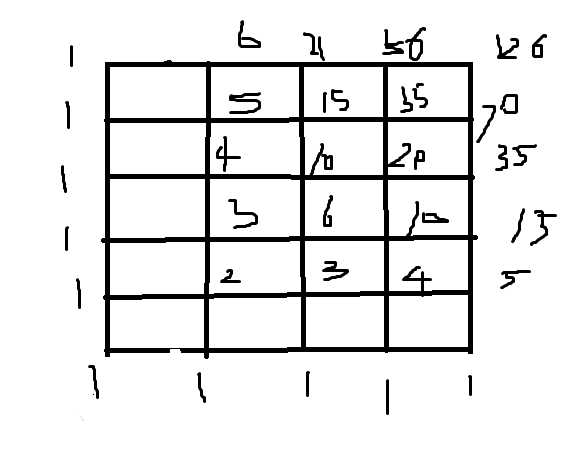POJ - 1942 D - Paths on a Grid
阿新 • • 發佈:2018-09-19
進行 cst 類型 eno because modern HERE pat att Imagine you are attending your math lesson at school. Once again, you are bored because your teacher tells things that you already mastered years ago (this time he‘s explaining that (a+b) 2=a 2+2ab+b 2). So you decide to waste your time with drawing modern art instead.
Fortunately you have a piece of squared paper and you choose a rectangle of size n*m on the paper. Let‘s call this rectangle together with the lines it contains a grid. Starting at the lower left corner of the grid, you move your pencil to the upper right corner, taking care that it stays on the lines and moves only to the right or up. The result is shown on the left:

Really a masterpiece, isn‘t it? Repeating the procedure one more time, you arrive with the picture shown on the right. Now you wonder: how many different works of art can you produce?
Fortunately you have a piece of squared paper and you choose a rectangle of size n*m on the paper. Let‘s call this rectangle together with the lines it contains a grid. Starting at the lower left corner of the grid, you move your pencil to the upper right corner, taking care that it stays on the lines and moves only to the right or up. The result is shown on the left:
Really a masterpiece, isn‘t it? Repeating the procedure one more time, you arrive with the picture shown on the right. Now you wonder: how many different works of art can you produce?
Input
The input contains several testcases. Each is specified by two unsigned 32-bit integers n and m, denoting the size of the rectangle. As you can observe, the number of lines of the corresponding grid is one more in each dimension. Input is terminated by n=m=0.Output
Sample Input
5 4 1 1 0 0
Sample Output
126
2
題意:輸入n,m,代表n*m的矩陣,求從左下角到右上角的方法有多少種
思路:用我們平常的加法原理可以得出這個答案,但是n,m範圍是unsigned int我們不能開這麽大的數組
我們可以發現其實我們肯定會走n+m步,其中n步向上,m步向右,我們走上,我們路線肯定是由
n個上,m個右組成,所以我們在這求出一個組合數C(n+m,m),代表從這個路線順序裏面挑出
m個位置為向右走,用C(n+m,n)也是一樣的結果
#include<cstdio> #include<cstring> #include<cmath> #include<algorithm> #include<iostream> using namespace std; unsigned C(unsigned n,unsigned m)//n,m的每個地方都記得用unsigned類型 { if(m>n-m) m=n-m; unsigned t1,t2; t1=n; t2=m; double vis=1.0; while(t2>0)//用double型存儲組合數,可以每次進行約分,如果是實在是整型不好存儲的話那就只能使用這個進行約分了 { vis*=(double)(t1--)/(double)(t2--); } return (unsigned)(vis+0.5);//四舍五入 } unsigned n,m; int main() { while(scanf("%d%d",&n,&m)!=EOF) { if(!m && !n) break; cout<<C(n+m,n)<<endl; } }
POJ - 1942 D - Paths on a Grid

